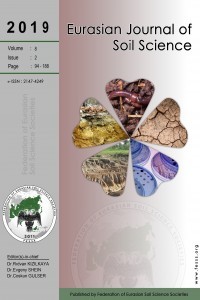
Eurasian Journal of Soil Science
Yazarlar: Samira NOROUZİ, Hossein KHADEMİ
Konular:-
DOI:10.18393/ejss.2015.3.144-152
Anahtar Kelimeler:Tree leaves,Heavy metals,Magnetic susceptibility,Enrichment Factor,Multivariate statistics
Özet: Studies on atmospheric dust have been limited by the high cost of instrumental monitoring methods and also sampling difficulties. The use of organisms acting as bioaccumulators has recently been proposed. In this study, the leaves of Platanus orientalis L., as a possible biomonitor of heavy metals in atmospheric dust, were evaluated to understand the likely source(s) of pollution in Isfahan, Iran. Concentration of Zn, Cu, Ni and Mn and Magnetic susceptibility (χ lf) were determined in washed (WL) and unwashed leaves (UL), monthly sampled from May to Nov., 2012. By subtracting the amount of metal concentrations and χ lf in UL and WL, the amount of these parameters in dust deposited on the leaves (UL-WL) were calculated. Enrichment factor analysis (EF), correlation coeficient, principal component analysis (PCA) and cluster analysis (CA) on the UL-WL data were employed to trace the heavy metals sources. Results showed that the metal concentration in UL and WL in primary sampling times was not statistically different. As time passed, this difference became more noticeable. Seasonal accumulation trends of elements concentration in UL-WL, referred to as accumulative biomonitors showing the accumulation of dust on the leaves are considerable and the contamination of plants by metal occurs mainly by retention of particulate matter. All the heavy metals are well correlated with χ lf, indicating the potential of magnetic measurement as an inexpensive and less laborious method to estimate heavy metals. Cu and Zn exhibited a very strong correlation with each other and the highest correlation with χ lf, suggesting an anthropogenic nature of these two metals. High EF of Cu and Zn showed that anthropogenic sources contribute a substantial amount of these metals to dust deposited on leaves. Whereas, less EF for Mn and Ni shows that natural source and local polluted soils might be the main origins of these metals. PCA results showed 2 principal components. Factor 1 with significant loading for Cu and Zn and factor 2 for Mn and Ni. In an agreement with the PCA and correlation results, CA showed strong clusters for Zn and Cu and also for Mn and Ni. Zn seems to originate from vehicular emissions, oil combustion and wear and tear of vehicle tires. Cu seems to originate from industrial processes, traffic and combustion of fossil fuels. Polluted soils in the area appear to be the main natural source for Mn and Ni in dust, while anthropogenic activities could be considered as the second origin.